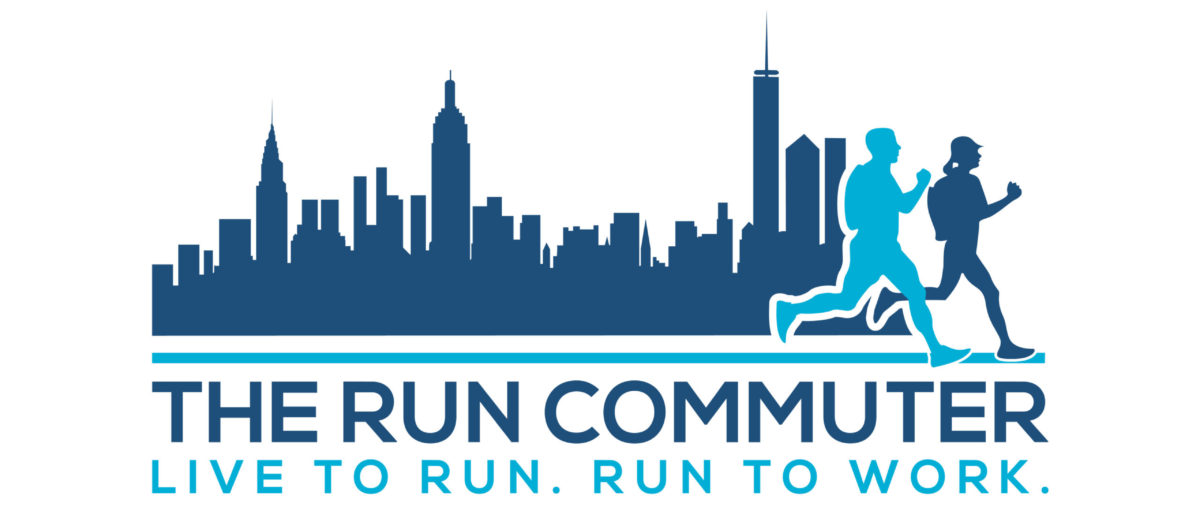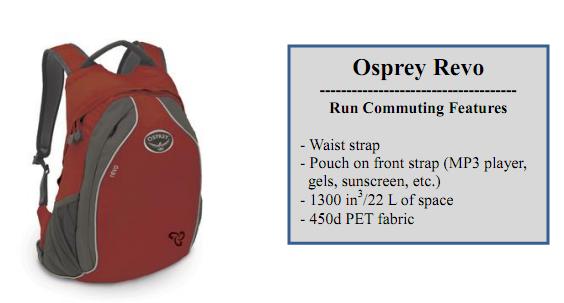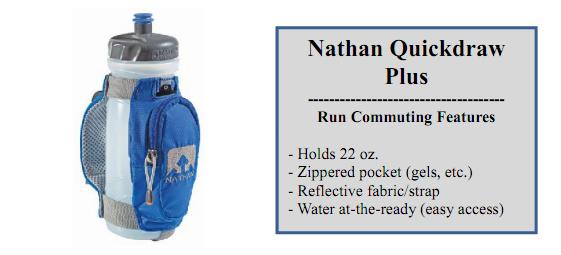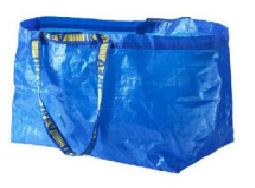This is my favorite thing to write about! I’m always interested in trying out new gear to see how well it will work for run commuting and over the years, I’ve really fine-tuned what I carry into a nice, reliable system.
There are three basic types of run commuting and your gear/equipment may vary depending upon which one you choose:
1) Morning commute only
2) Evening commute only
3) Morning and evening commute
One other factor that will alter your list is weather. For #3’s, you’ll need to be prepared for the conditions in the morning and late afternoon. It might be nice out when you run to work, but pouring rain and windy on the way home. Be sure to check the day’s forecast before you leave each morning and pack accordingly.
Note that these lists are for an office-type job, where you have some sort of personal space of your own. They are not exhaustive or gender-specific either, so each individual should add or drop their required items accordingly.
The Run Commuting Backpack
Now that you have an idea of what to carry, you need an idea of what to carry it with. A backpack, of course! But not just any backpack will work. You will need one with a couple of special features. For the past several years, I’ve been using the Osprey Revo (discontinued).
Osprey makes some AMAZING packs and this one – while very basic – is no exception.
The Revo is mostly made from recycled PET (soft drink/water bottles) and has a few reflective bits on the front and back. Let me tell you something about the fabric though – I’ve NEVER washed this pack and I am constantly drenching it with sweat or mud or spilled drinks and it never smells (and runner’s funk can be pretty bad) or stains. It is not waterproof, so the contents inside will get damp during downpours, but not through the back from sweat. This is definitely an excellent feature.
The 1300 in3 carrying space is a pretty ideal size for bringing all the things to work you might need (including the occasional pair of shoes) and also leaves room for a little bit more. I mostly run with mine half empty. On days where you wear warm clothes to run into work and less on the way home, the extra space gets filled quickly. There is also a laptop sleeve inside if you need to carry a laptop around with you.
The waist strap is the most essential component of this pack by far. If you have ever tried running with a normal backpack, you will experience the bouncing and side-to-side motion that an improperly-suited running backpack produces. The Revo has a simple, non-padded strap with an easy to release buckle that cinches down tightly and does not loosen. I have not felt the need for a sternum strap, but one can be added to any pack cheaply and easily.
With any pack, the fit of it depends on a number of factors; including the person’s body type, carrying requirements, etc, so try your run commuting backpack out at a store before you buy one.
Oh, and how much does it weigh full of gear? Between 8 – 15 pounds. Your shoulders might feel tender after the first run, but it goes away quickly and you shouldn’t feel it again if you’re a regular run commuter.
Accessories
Water Bottle
It is an absolute necessity to carry water with you while running around Atlanta in the summer, but wherever you run, it’s a good idea to always have water with you.
A simple water bottle with a lid that you can easily open while running works just fine. You can keep it in the side pockets of your pack for easy access.
Kyle and I have been using the Nathan Quickdraw Plus for a while now and we prefer them over just a regular water bottle.
Not a whole lot to say about this great product. It carries a decent amount of liquid (enough for about 5.5 miles for me), your water is always at the ready (no reaching around your pack) and it adds some additional reflectivity that all of us runners could use out on the road.
Rain Protection for Your Gear
I run no matter what the weather is like outside so I need to keep my work clothes dry. I found the cheapest and simplest solution to be sitting in our pantry – an Ikea shopping bag.
You can buy these at Ikea or online for less than $1 each. They’re monstrous – as in 4,346 in3 of carrying capacity – and made of 100% polypropylene (easy to clean, waterproof).
I’ve also used regular water-repellant, reusable shopping bags and even plastic grocery bags at times with decent results. Use whatever you have around you!
I’ve recently upgraded my rain protection gear. Osprey also makes rain covers for packs and they come in four sizes to accommodate almost anything you can carry on your back. I have not used it yet, but I’ll be sure to post a review after testing it out.
Like I said earlier, this isn’t an exhaustive list of equipment, but we’ll continue to add more reviews and updates as we go along to keep you current.
Now you know what to bring on your run commute and how to get it all there.
— Josh






I have lots more to say about the Nathan Quickdraw, as well as the Nathan Quickdraw Elite, a recent acquisition. I will have a review soon of the latter (and on my running gear); however, here are some points on the regular ol’ Quickdraw:
The distinct advantage the Quickdraw boasts over one’s standard 12- 16-ounce water bottle is its colorful, hand-strapped holster. For three miles, maybe five, it really matters little: any bottle would do. You likely could even employ a Mason jar, which is particularly acceptable for any mountain, hill or country folk: you will better blend in and they will be slower to slander you as “city folk,” two words that, in many locales, are fightin’ words. They might, however, take exception to your shorty-short split shorts.
At 10K and beyond, the Quickdraw aids your grip. Yes, this is a problem. As form falters with fatigue’s onset, you will slump, drag your feet, stumble, run less efficiently; too, you will begin noticing the weight of your hand held hydration pendulum. Your formerly calm hand will become a claw, clenching and crushing the figurative egg or potato chip or fluffy pet you were to pretend your palm cupped. Sorry, Algernon, you won’t be getting those flowers.
Wedge your hand between the bottle and its mesh backing, then pull the reflective fastener ’til you reach your comfort point. I sometimes find difficulty finding the proper palm-on-bottle comfort zone, but other times it feels like they were made for each other. The mesh backing is uncomfortable and scratchy, and seems to breathe poorly.
Despite that, it works wonderfully. I spend less time shifting my grip than with a regular bottle, or playing hot potato with the bottle when fatigued. Previously, and sometimes upon occasion, I run with an REI Singleshot waist pack. Like many users, I have found the tensioning system to be a little awkward; if positioned less than perfectly and unless it is tightened to the max on my hips, it can be bulky and bouncy. The hand held Quickdraw saves Josh the awkward situation of standing around while I struggle to position my fanny pack, muttering and cursing my gangly hips.
The Quickdraw has room enough in its pocket for two GUs or one Larabar, maybe a folded-up $10 bill and one key: no more than one key. It is a tight fit. But you are not running to brunch or your knighthood ceremony with the Queen (hopefully), so that is really all you need.
great series of articles. thanks for posting this info up.
i do have one question in regards to being a one-way morning run-commuter.
you’ve got your clothes, food for the day and wallet/phone/etc packed into your backpack… roughly, how much does your pack weigh?
For me, it ranges from 8 – 12 pounds, depending on the clothing I bring (khakis/polo shirt vs. dress pants/long sleeve shirt/sweater) and the type of lunch I have (sandwich/chips vs. lasagna leftovers).
Same here as with Josh, Chris: maybe about 8-12 pounds. Typically the heavy items are my lunch and clothes, maybe a book if I bring it. Lunch is often rice and beans, tofu, greens and so forth. Healthy, light crap. I found a locking container that fits perfectly in my backpack.
Clothing is seldom a concern. I pack a 7- to 10-day supply by bike, then store them in an empty filing drawer: my workplace wardrobe. I keep a suit hanging on the back of my door. When I have gone through my supply, I pack ’em out and replenish.
The heaviest things I have carried are a hydration bladder for extremely hot days, and a 5-pound case of strawberries for Lo-town. It forces you to focus critically on what you actually need to bring along. That book? This coffee thermos? That sack of marbles? Nah: nix.
Great post, guys! I just found your blog when researching a blog post. I wish I had known about it several months ago when I was shopping for a backpack though! Luckily I wound up finding the perfect fit – not sure this one would work for you fellas, but Sophie might get a kick out of it! http://ow.ly/aWRmu
Thanks! You’ve got a great blog and that was a great review of a run commuter pack! It hit on all the important points and was awesomely visual…
Having a pack that fits just right is crucial for running and we’re big fans of Osprey here for that reason. Not only can you cinch down the chest and waist straps, but you can compress the gear you are carrying on some models, as well. I think our next review might just be the Nike Cheyenne Vapor pack, though. I’ve heard good things about that one and I’m anxious to give it a go.
Hi Josh, thanks for this helpful post! I was wondering how you apply to the ikea bag. Do you somehow wrap it over the Osprey bag?
In this case, you would first pack your pack’s contents into the Ikea bag (clothes, shoes, cell phone, wallet, etc.), then wrap it all up, and place the parcel inside your backpack. It’s not ideal, but it is definitely effective.
Thanks for amazing information
I’m planning to start run commuting (only one or two evening a week) soon, a 14K distance. I’m looking at the Osprey Daylite. Do you think it would be suitable to carry a change of clothes, diary + pencil case and a few snacks?
The Daylite seems like a good 13L pack that should fit all those things just fine.